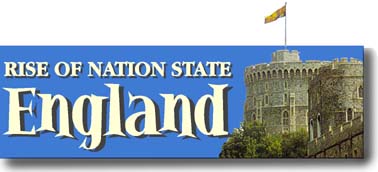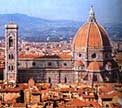|
Highlands Ranch High School - Mr. Sedivy
Highlands Ranch, Colorado
Rise of Nation State England
- Wales and Scotland
-
Edward I, Llewellyn, Snowdonia
Wales and Scotland
Scottish and Welsh hill folk grew up as separate people, kept their
own rulers, language and tradition. Welsh land is rugged mountainous
land. There are very few areas flat enough to be plowed and sown
with crops - along river valleys and on the Isle of Anglesey. Up
in the hills, scattered tribes of herdsmen lived. Wales and Scotland,
unprotected by sea, faced frequent attacks from the neighboring
English.
Edward I (1272 - 1307)
Under Edward I, the English made their great assault on Welsh and
Scottish freedom. Edward tried to master the mainland of Britain.
"Warlike as a leopard,
Edward shines out like a new Richard."
 
Left: Edward I is pictured "creating" his
son, Edward Prince of Wales. The scene
symbolizes the English acquisition of the principality of Llywelyn
ap Gruffydd.
Right: King Edward I faces king Philip IV of France.
Llewellyn
When Edward I became king, Snowdonia was ruled by a powerful chief
named Llewellyn (Llywelyn). He had recently re-conquered most of
central Wales. In a treaty made with Edward's father, Henry III,
Llewellyn had agreed to pay homage to the English King as his overlord.
But when Edward came to the throne the Lord of Snowdonia, Llewellyn
missed the coronation ceremony and proudly refused to renew his
homage.
Edward declared war. Llewellyn retired to the safety of the mountains.
He was soon starved into surrender when Edward's ships cut off corn
supplies from Anglesey. The King treated Llewellyn fairly. Once
he had paid homage, he was left in control of Gwynedd, but he had
to give up his other lands.
David
David was Llewellyn's brother. Complaining at the harsh treatment
of his countrymen by English officials, David rebelled in the spring
of 1282. Llewellyn joined him, reluctantly, and all Wales rose in
revolt. The King now decided to crush the troublesome Welsh once
and for all.

The death of Llywelyn ab Forwerth in 1240. His sons,
Gruffydd (a bastard) and David look on. It took Llywelwyn's grandson,
Llywelyn ab Gruffydd, almost a decade to reassert undivided princely
rule in Gwynedd.
Llewellyn was killed in a skirmish December 1282. Llewellyn's head
was sent in triumph to London and fixed on a spear above the Tower.
Six months later, David was captured and executed.
The Welsh were no longer independent, but to this day they have
kept alive their Celtic language and many old customs.
Castles Among the Conquered
To strengthen his hold on Wales, Edward built castles round the
fringes of Snowdonia. Instead of having a single square keep, like
earlier stone castles, Edward's architects planned concentric defenses
- Inner ward. Here any attackers who got past the main gate would
be caught between two showers of arrows. In these later castles,
towers curving outward made it easy for defenders inside to shoot
along faces of the wall. Edward I's great Welsh castles still stand
today as monuments.
Edward II, Prince of Wales
Edward II was born in 1284. When the young Edward was seventeen,
his father gave him the title "Prince of Wales." Ever since, the
king's eldest son has received the same honor.
Back to top of page
Mr. Sedivy's Lecture Notes
& Historical Info
The Celts
| Gallic He-Men | Celtic
Culture, Trade, Religion, Women |
| Threat of the Celts - Celtic Battles and
Conquests |
- Rise of Nation State England -
| Roman Conquest of Britain | Christianity
in Britain |
| Customs: Thanes, Churls, Thralls, Wergeld,
Folk-Moot |
| Dark Ages: Alfred the Great, Edward the
Elder, Athelstan |
| The Return of the Vikings |
| Kings of Britain: Aethelred, Cnut, Edward
the Confessor |
| Bayeaux Tapestry, William the Conqueror,
Edward the Confessor, Harold Godwinson, Harold II |
| The Crusades: Richard Lion Heart, Pope
Urban |
| King John, Innocent III, Archbishop Stephen
Langton |
| Magna Carta / First Parliament |
Wales and Scotland
| Wales: Edward I, Llewellyn, Snowdonia
|
| Scotland: Alexander III, John Balliol,
William Wallace, Robert Bruce, King Edward II |
The 100 Years War
| Edward III, Longbows at Crecy, Edward IV,
Black Prince |
| Henry V, King Charles VI, Battle at Calais,
Treaty of Troyes |
More Information
| Other Kings of the Dark and Middle Ages:
William II, Henry I, Henry II |
| The
British Monarchy's Peerage: Dukes, Viscounts,
Marquess, Earls, Baronets, and Barons |
Class Activities
Roman Conquest Comparison
Battle of Agincourt
Related Information
Mr. Sedivy's World History - The Middle
Ages
The Complete Bayeux Tapestry
Roman Catholic Church in the Middle Ages
/ Crusades
The Hundred Years War
King Henry VIII
The Interesting
Life of Elizabeth I
The Stuarts - James I, Charles I, Charles
II, James II
Oliver Cromwell
|



![]() 9375 South Cresthill Lane
9375 South Cresthill Lane ![]() Highlands Ranch, Colorado 80126
Highlands Ranch, Colorado 80126 ![]() 303-471-7000
303-471-7000



